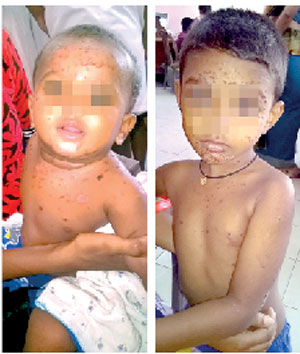News
Save your skin from the sun

An old bath tub put to good use: These children in Slave Island, frollic in the water to beat the heat. Pic by Amila Gamage
The scorching rays of the sun beat mercilessly on all of us, without discrimination be it man, woman or child.
The ‘natural’ protector of our bodies from these ultra-violet rays is the skin and it is a team from the Dermatology Unit of the Lady Ridgeway Hospital (LRH) for Children which gives us advice on how to safeguard this asset.
Climate change being the trigger for all our woes whether it is the unbearable heat, the violently swinging pendulum between droughts and heavy rains or the tragedy-filled natural disasters, Prof. Jayamini Seneviratne, Head of the LRH’s Dermatology Unit, talks of the bigger picture.
“Each one of us needs to look at ways to cut down our contribution towards climate change,” says Prof. Seneviratne, pointing out that as a country we need to stop the destruction of our forests. We need to stop cutting down trees.
The images are grim and we need to do something about climate change, he says, pointing out that there is speculation worldwide that if the ice in Siberia melts the bodies of people who have died of small pox and have been preserved due to the freezing conditions would release the virus, bringing back the spectre of this plague.
The current issues of sun and skin, however, are more mundane. Sweat/heat rash or prickly heat (miliaria), severe sunburn and photo-dermatitis are the things which we should worry about right now, the Sunday Times learns.
4 Sweat rash — The mildest form of heat rash (miliaria crystalline) affects the sweat ducts in the top layer of skin, with the indications being clear, fluid-filled blisters and bumps (papules) that break easily. If it occurs deeper in the skin (miliaria rubra), red bumps could erupt along with itching or a prickly sensation. Rarely, these bumps could get inflamed and pus-filled. Skin folds and where clothing rubs against the body are the usual heat-rash areas in adults, while in children, especially babies, it can occur on the neck, shoulders and chest and also in the armpits, elbow creases and groin.
4 Sunburn – The skin turns red and hurts and if it is severe there could also be swelling and blisters, in the wake of which will come the peeling of the skin and itching.
4 Photo-dermatitis – This is an abnormal skin reaction to ultra-violet rays. There could be a rash, blisters, scaly patches and hyper (more than the skin colour) or hypo (white) pigmentation.
“To prevent these three conditions, heavy exposure to the sun should be avoided from about 9 in the morning to 5 in the evening,” stresses Senior Registrar Dr. Thulasi Weerasinghe, explaining that if a person has to work or get about under the blazing sun, a few simple measures would be essential.

Impetigo, a very common bacterial skin infection which could follow a heat rash. Frequent bathing is the answer to prevention
This is where umbrellas and hats with wide-brims come in handy, as also loose cotton clothing with long-sleeves so that a large part of the body is covered. Newborns and infants should be free of mittens and socks and should not be covered with blankets. Cotton clothes would also be ideal for them.
According to Dr. Weerasinghe we should try to “stay cool” whenever possible by being in the shade or under a fan. Parents should try to keep children free of ‘necklaces’ of sorts like the thick black thread around their necks as these could lead to the development of infections following a sweat rash.
“Don’t use creams and lotions as they too could aggravate these conditions,” she says, explaining that the easiest ‘antidote’ is bathing daily or twice a day and having a wash whenever possible, keeping the hair of small children very short or in bigger children tied up, away from the neck.
Dr. Weerasinghe adds that personal hygiene is of paramount importance, as otherwise the skin could become the grounds for increased fungal, bacterial or viral infections. If, however, someone gets any of these skin conditions and it persists, treatment should be sought from a hospital.

